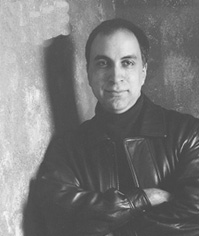
Composer Anthony Cornicello (born in Brooklyn, New York, 1964) writes music that blurs distinctions between performers and electronics, timbre and harmony, composition and improvisation, and explores the boundaries of what may be considered post-classical concert music. His music is vibrant and visceral, full of rhythmic energy and harmonic sophistication, and his forays into live electronics have led to exciting combinations of instruments and processed sound. Cornicello’s background as a jazz pianist is evident not only in the rhythmic activity of his music, but also in his constant investigation of the rich sonorities available from a variety of instruments.
He has been commissioned to write music for the Scorchio Electric String Quartet, ModernWorks! (funding from Meet the Composer/ Commissioning Music USA), the Auros Group for New Music, the Prism Saxophone Quartet, the New York New Music Ensemble, David Holzman, the Group for Contemporary Music, and the InterEnsemble of Padova, Italy. His work has also been featured on the Guggenheim Museum’s “Works and Process” series. Cornicello’s works have also been performed by the Chicago Civic Symphony, Parnassus, ALEA III, Composers Concordance, Madeleine Shapiro, Robert Black, among many other outstanding groups and solo performers. His music has been presented as part of the Darmstadt International Festival of New Music as well as the June in Buffalo Festival.
Cornicello’s Second String Quartet has been recorded by the Atlantic String Quartet; the Second Sonata for Piano by David Holzman (Centaur). More recently, his Post-Modern Waltz was recorded by Eric Moe for Albany Records. A portrait CD of Cornicello’s works is scheduled for 2006 release on Albany Records.
As a performer, he has conducted or played piano in his own works on numerous occasions. While a graduate student at Rutgers, he formed and directed the Janus Ensemble, a group dedicated to contemporary music. More recently, Cornicello has begun performing on the laptop, using a variety of interfaces and the Max/MSP program. Those performances, mostly with EEE!, have had a notable impact on his music, as EEE!’s music ranges from hip-hop to experimental noise. EEE! is based at Eastern Connecticut State University, where Cornicello is an Associate Professor and Director of the Electronic Music Lab.
Cornicello received the Ph.D. from Brandeis University, where he studied with David Rakowski, Eric Chasalow, and Martin Boykan. His teachers also include Charles Wuorinen, Gérard Grisey, and Richard Beirach.
His current fields of interest include developing unusual interfaces for live computer music performances, as well as continuing to investigate resonance and spatialization. His recent and current projects (mostly for string instruments and electronics) have been exploring the latter two, and the series of experimental works ReZenant Garden, performed by EEE! have operated on all three areas of interest. Future projects will include works for instrumental groups or soloists and electronics, as well as turntablists.
Cornicello's works are published by C.F. Peters Corporation and APNM, and he is a member of BMI.
|
|
|
|
|
|

Monday, April 23, 2007
Review: Electronic Music in CT, week 1
For starters, I'm not going to review the EEE concert. It's my own group, so I can't review it.
I will talk about the McLean Mix Duo. First of all, I've heard of them since the 1980s. They've been around, doing these touring electronic music shows long before it was easy, and back when it was cool, hip, and innovative. Before asking them to come, I listened to some of their music on their website, and I did buy some of the their CDs. The music sounded good, although I could tell it was on older equipment. I didn't get a chance to see any of their videos online, but their site did have still photos.
On Wednesday, they came to Eastern and set up their Rainforest installation. It was a cool event - nice ambient rainforest sounds, plus some audience interactive elements (you could go up to one of 5 stations and add sounds to the 'environment'). The installation was to run all day, from 12 to 5PM. When I explained to them (for what must have been the 10th time since I began talking to them last year) that they needed to do an hour-long presentation at 3 PM (for the University Hour program that was paying them!), they seemed to not want to do it, for whatever reason. They eventually did a presentation, although I was a bit taken aback at how unprepared they were: they've been touring with the Rainforest since 1989, and you'd think that they would have come up with a solid hour-long presenation by now.
That's when things began to unravel for me. They gave a short presentation for a small group of students regarding their Max patches, which was slightly informative. Their concert on Thursday evening epitomized what they're about: older equipment, sloppy production values, and a somewhat cheesy approach. I'm sorry, but I must be blunt.
The first half of the concert was all videos with pre-recorded music (not, by the way, accurately described in their promotional material). The videos were dated looking, and they used the same video effects ad naseum. The music wasn't bad, but it was subverted by the video. The second half was much better, with live music played against a video.
All together, I was not impressed.
==============
One other issue: student attendance. I've certainly been talking this up amongst my students, and I haven't said any of my feelings about the music to them. I even made going to one of these concerts mandatory. Yet, not many students showed up. It gets frustrating, and I don't recall this kind of apathy at the schools I went to - particularly when a professor of mine was actually organizing and participating in the event. How is this handled at other schools? Is it a problem? (Sure, there are conflicts - other classes, gigs, and then there are excuses - I'm going somewhere, my dog was sick, etc.)
posted by Anthony Cornicello
|
| |



